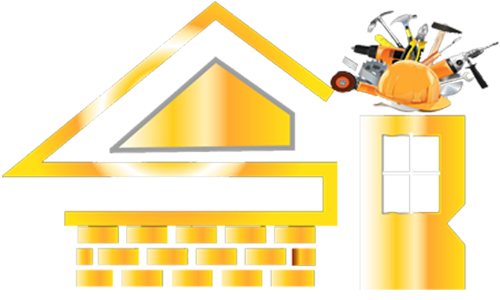
Which roof type truly fits Brooklyn life: an intensive green roof or an extensive green roof?
If you own or manage a building in Brooklyn, you want a roof that cools the block, minimizes noise, and looks great from the street or the skyline. The choice often comes down to Intensive vs Extensive Green Roof. An intensive green roof resembles a genuine garden, complete with walkways and areas to relax. An extensive green roof emphasizes efficiency by the use of resilient plants that require minimal maintenance and a slim appearance. Both add value, yet they solve different problems.
In this guide, we provide a clear explanation of the meaning of each system. You’ll see how soil depth, weight, plant choices, cost, and upkeep play out on real roofs in a dense, coastal city. You’ll also learn where a semi-intensive option fits when you want more variety without a heavy build. Let’s unleash all the secrets!
What Are Intensive and Extensive Green Roofs?
Extensive green roofs utilize a thin layer of soil and resilient, low-maintenance plants. They keep the weight and cost low while still helping with rain control and extending roof life. Intensive green roofs feel like real gardens with deeper soil and a wide range of plants, even small trees. They look great and invite people to use the space, but they need a stronger structure and more care.
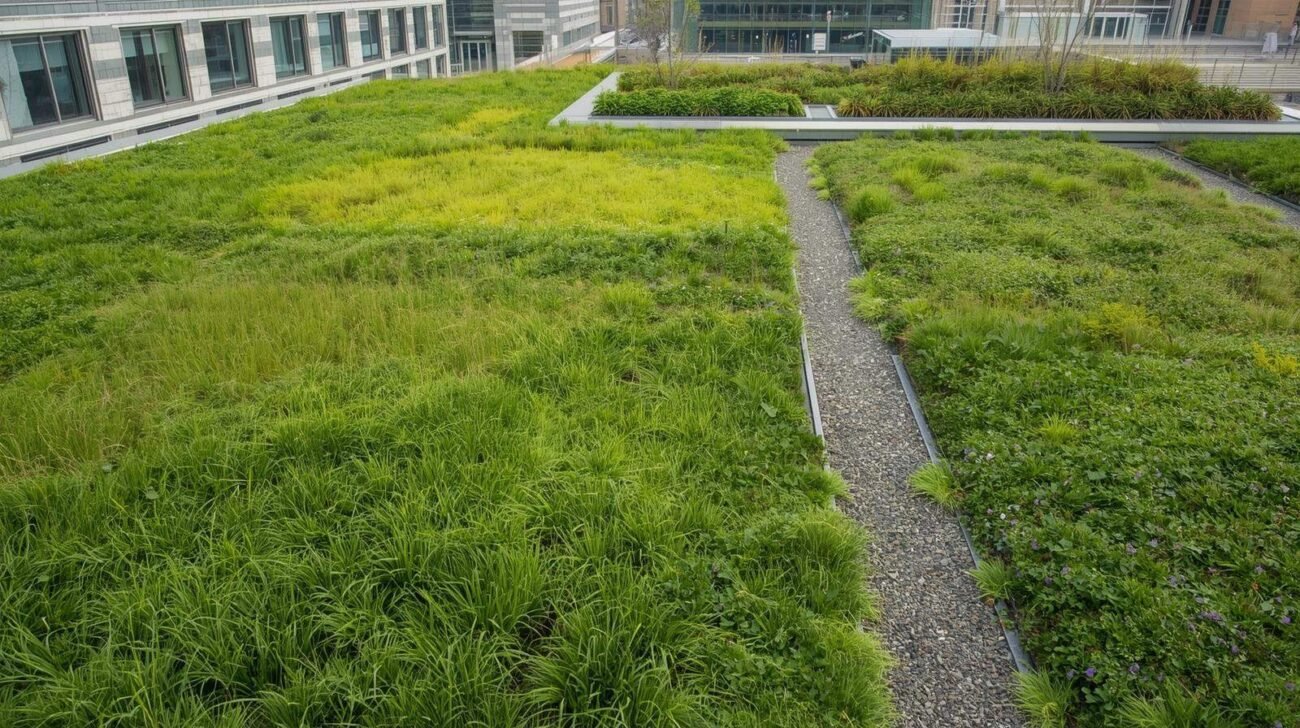
10 Key Differences of Intensive vs Extensive Green Roof
In short, intensive roofs are deeper, heavier, and built for people to use; extensive roofs are lighter, simpler, and focused on performance. They differ in terms of soil depth, weight, plants, access, irrigation, upkeep, cost, design choices, and suitability for specific projects. We uphold the full comparison below so you can choose with confidence.
How Deep Is the Soil in Intensive vs Extensive Green Roof Systems?
Most extensive roofs use about 60–150 mm of soil (roughly 2.5–6 in). Some ultra-light sedum systems go as thin as 20–50 mm (0.8–2 in). Most intensive roofs start around 150 mm (6 in) and can reach 600–800 mm or more (24–32 in+) in planted zones. Deeper soil supports larger plants and holds more water. Thin build-ups suit hardy, shallow-rooted plants and lighter structures.
Structural Load: Intensive vs Extensive Green Roof Compared
Typical saturated weight (rules of thumb)
| Roof Type | Approx. Range (kg/m²) | Approx. Range (psf) |
| Extensive | 60–130 | 12–27 |
| Intensive | 160–600+ | 33–125+ |
Key notes
- More depth means more weight; pavers, planters, and furniture add even more.
- Engineers check live load, dead load, and safety factors before approval.
- Lightweight extensive systems are suitable for roofs with limited spare capacity.
- Intensive roofs require a stronger structure and a carefully designed drainage system.
Extensive vs. Intensive Green Roof Plants
| Extensive (Plant) | Common Name | Intensive (Plant) | Common Name |
| Sedum album | White stonecrop | Lavandula angustifolia | Lavender |
| Sedum spurium ‘Dragon’s Blood’ | Two-row stonecrop | Heuchera spp. | Coral bells |
| Sedum reflexum ‘Blue Spruce’ | Stonecrop | Echinacea purpurea | Purple coneflower |
| Sedum rupestre ‘Angelina’ | Golden stonecrop | Rudbeckia hirta | Black-eyed Susan |
| Sedum acre | Goldmoss stonecrop | Salvia nemorosa | Meadow sage |
| Delosperma cooperi | Ice plant | Calamagrostis ‘Karl Foerster’ | Feather reed grass |
| Dianthus deltoides | Maiden pink | Miscanthus sinensis | Maiden grass |
| Thymus serpyllum | Creeping thyme | Cornus sericea | Red osier dogwood (shrub) |
| Allium schoenoprasum | Chives | Acer palmatum (dwarf forms) | Japanese maple (small tree) |
| Festuca glauca | Blue fescue | Amelanchier spp. | Serviceberry (small tree/shrub) |
Which can last longer: Intensive vs Extensive Green Roof
Both roof types can last for decades when the waterproofing, drainage, and root barrier are done right.
Extensive roofs often reach 30–50 years because the thin, stable build sees little foot traffic and shields the membrane from sun and heat swings.
Intensive roofs can match or exceed that, since deeper soils provide extra protection, but the added use, irrigation lines, and features can cause wear that requires steady care.
In plain terms, upkeep decides the winner: regular checks, clear drains, sound flashing, and quick fixes keep both systems strong.
If you want the longest life with the least risk, opt for extensive; if you want a long-life roof that you can use as a garden, choose intensive and plan for a tighter maintenance routine.
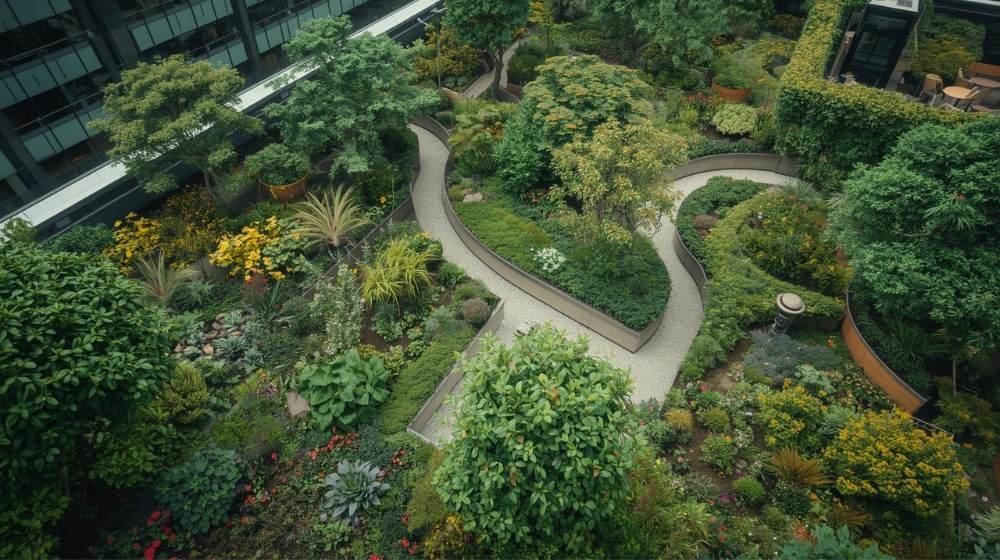
Maintenance Needs of Intensive vs Extensive Green Roof Options
Extensive
- Clear drains and inspect outlets at least twice a year to prevent clogs and ensure proper functioning.
- Pull weeds and remove volunteer trees twice to three times a year.
- Keep pebble fire breaks and edges clear of plants.
- Check for bare spots after storms and top up the media if needed.
- Use fertilizer only if plants show stress; avoid runoff into tanks.
- Water during the first season and long droughts; no permanent system in most cases.
Intensive
- Plan seasonal pruning, lawn care, and debris clean-up.
- Test and tune irrigation each spring and mid-summer; fix clogged emitters.
- Replace failed plants, top up settled substrate, and refresh mulch.
- Inspect hardscape (pavers, railings, furniture) for safety and wear.
- Watch for pests and disease; follow IPM basics.
- Keep outlets and inspection chambers open and clean.
Which is easier to maintain?
Extensive roofs win in maintenance tasks. They require a few visits a year and little water after they are established, while intensive roofs act like rooftop gardens and need regular care.
Do Intensive vs Extensive Green Roofs Require Different Irrigation Systems?
Extensive
- Temporary sprinklers for the establishment phase.
- Subsurface drip line grids are set in the root zone.
- Capillary/water-retention mats to hold moisture below the media.
- Manual hose bib/standpipe points for drought back-up.
- Rainwater harvesting + simple controllers to feed the drip system.
Intensive
- Pop-up spray/rotor sprinklers for turf areas.
- Surface or subsurface dripline for planting beds and shrubs.
- Tree bubblers/point emitters for planters and trees.
- Smart controllers with moisture or weather sensors.
- Fertigation injectors add nutrients through the system when needed.
Bottom line
Extensive roofs often skip permanent irrigation after they are established, except on hot, windy sites; intensive roofs do best with permanent, zoned systems because of their deeper media, variety of plants, and regular use.
Cost Breakdown: Intensive vs Extensive Green Roof (per sq. ft.)
Actual costs depend on roof size, access, depth, and plant mix. The ranges below reflect typical U.S. projects today; large roofs tend to be cheaper per square foot, and NYC incentives can offset the totals.
| Green Roof Type | Material Cost | Labour Cost | Maintenance Cost (annual) | Installation Cost (total) |
| Extensive | $7–$18 | $5–$12 | $0.75–$1.50 | $12–$30 |
| Intensive | $15–$35 | $10–$25 | $1.25–$2.00 | $25–$60 |
- Maintenance ranges from $0.75 to $2.00/ft²/yr, depending on the type and design.
- Many guides quote installed costs of $10–$25/ft² (extensive) and $25–$50+/ft² (intensive); big, complex gardens can run higher.
- GSA found extensive roofs cost $10–$12.50/ft² more than a black roof, with semi-intensive roofs $16–$19.70/ft² more, and that bigger roofs cost less per ft².
- NYC’s tax abatement can credit $5.23 to $15.00/ft² toward eligible green roof area, which reduces your net cost.
Extensive Green Roofs Deliver Low-Maintenance Eco-Benefits
An extensive roof is a light, simple layer of large plants that works hard for you. It cools the roof, slows stormwater, and shields the waterproofing from sun and heat. Most sedums handle dry spells, so you check them a few times a year and keep drains clear. If you want greener views without a big bill, this is an easy win.
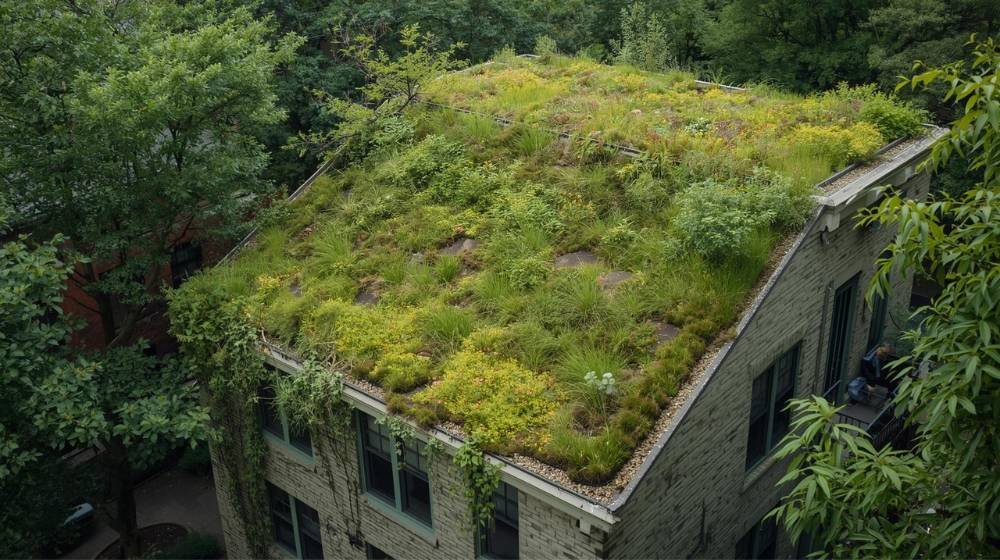
Intensive Green Roofs Create Recreational and Social Spaces
An intensive roof feels like a real garden above the street. You can add paths, benches, lawns, shrubs, and even small trees. Your family and friends can gather there, and residents get fresh air without leaving the building. It needs a stronger deck and a steady care plan, but the payoff is daily use.
Which Projects Benefit Most from Intensive vs Extensive Green Roofs?
Extensive: Best fits
- Large, flat roofs on schools, offices, and warehouses
- Retrofits with tight weight limits
- Projects that want stormwater credits at a low cost
- Budgets that favor simple upkeep
- Roofs with little or no public access
- Sites that want fast coverage with sedum mats
Intensive: Best fits
- Apartment and mixed-use buildings that want amenity space
- Hotels, campuses, and healthcare sites that value calm gardens
- Urban farms or pollinator habitats with diverse plants
- High-profile roofs where looks matter
- New builds with strong concrete decks and good access
- Projects that can support permanent irrigation and routine care
Bottom line: pick extensive for wide, low-cost eco gains; pick intensive when you want a place people can use and you have the structure and budget to support it.
What is a Semi-Intensive Vegetative Roof?
A semi-intensive vegetative roof is a combination of an extensive roof and an intensive roof. It utilizes a medium depth of growing soil and supports a greater variety of plant species than an extensive system. This extra depth allows you to include flowering perennials and small shrubs, yet the total weight remains lower than that of a full intensive garden. For many Brooklyn roofs, it is a smart compromise when you want to improve curb appeal without a major structural upgrade.
Which Green Roof is the Right Choice for Brooklyn Properties?
For most Brooklyn buildings, an extensive green roof is the practical choice. It keeps weight and cost down, reduces storm-water runoff, and cools the building with minimal effort. Pick an intensive roof only if your structure can safely carry the load and you truly need a usable rooftop garden for residents or guests. If you want a middle path that looks nicer from the street and still limits weight, a semi-intensive system is a great option.
Expert’s Tips for The Care and Maintenance of Green Roofing
Care stays simple when you follow a short list and keep photo logs. Set a calendar, assign a responsible person, and walk the roof on a routine.
- Check drains after big storms and every spring and fall.
- Inspect seams, flashings, and edges before each growing season to ensure they are in good condition.
- Water new plants on a schedule for the first summer, then follow a dry-spell rule.
- Pull weeds and tree seedlings while their roots are still small.
- Add extra media at corners and parapets where wind hits hardest.
- Test irrigation lines, timers, and back-flow devices at the start of summer.
- Keep a one-page log with dates, photos, and brief notes on small fixes.
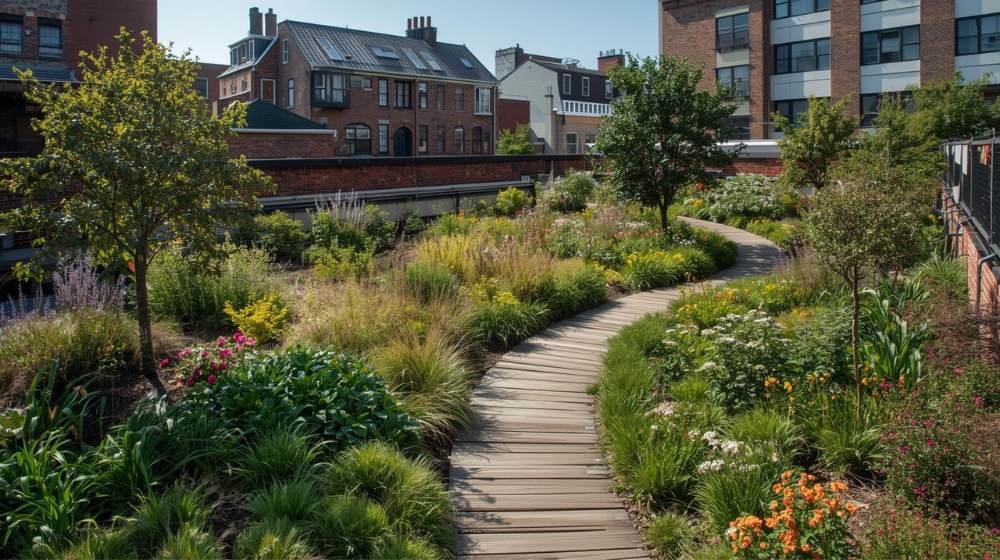
Why should you choose a professional roofing contractor?
Are you looking for an expert roofing contractor in Brooklyn, NYC? SR General Construction has you covered! Our business is located at 8807 Avenue B, Brooklyn, NY 11236, United States, in the Canarsie area.
We proudly serve all areas of Brooklyn with high-quality, durable roofing solutions. From new installations to repairs and maintenance, we provide the best service at affordable prices. Contact us and experience why we’re Brooklyn’s roofing experts!
FAQ
1. What is the main difference between an intensive and an extensive green roof?
An extensive green roof uses shallow media and low-growing, drought-tolerant plants and is designed for low maintenance and light weight. An intensive green roof uses much deeper media so it can support lawns, shrubs, and sometimes small trees, and is designed for human use and landscape variety.
2. How deep is the growing medium for each type?
Extensive systems generally have about 20–150 mm (0.8–6 in) of media, while intensive systems start above approximately 150 mm (6 in) and can reach 600–800+ mm when trees or large shrubs are used. Semi-intensive systems fall between these ranges, typically around 150–300 mm.
3. How much extra weight will a green roof add to my building?
Typical saturated weights for extensive roofs are roughly 10–35 lb/ft² (≈49–171 kg/m²), and for intensive roofs, weights commonly range much higher, up to 150 lb/ft² or more, depending on depth and hardscape. Pavers, planters, furniture, and people add significant additional living loads.
4. What will a green roof cost to install in Brooklyn?
Installed costs vary widely, but typical ranges for extensive roofs fall around $7–$30 per square foot, and intensive systems commonly run $25–$60+ per square foot, depending on access, media depth, and plant complexity. Large contiguous installations usually lower the per-square-foot price.
5. Do intensive and extensive roofs need different irrigation systems?
Yes — extensive systems often rely on temporary watering during establishment or passive retention mats, while intensive roofs typically need permanent zoned irrigation with driplines, pop-ups, or tree bubblers and smart controllers. Rainwater harvesting is commonly paired with permanent systems to reduce potable water use.
6. How long will a green roof last?
When waterproofing, root barriers, and drainage are properly installed and maintained, both types can last for decades. Extensive systems often show a 30–50 year service life due to low foot traffic, while intensive systems can match that with disciplined maintenance. The membrane’s installation quality and ongoing maintenance are the primary drivers of its lifespan.
